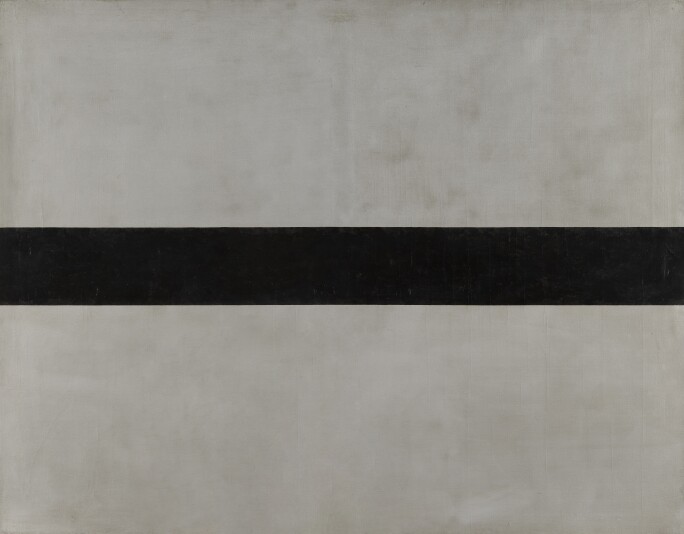Dated 1964-1989, the painting Silver Line (on White Background) is a seminal work by Croatia’s most important conceptual artist. Josip Vaništa was an outstanding figure of the Croatian neo-avantgarde movement. Between 1961-64 he created a series of paintings in which a horizontal, monochrome line was set against a monochrome background. Radically simple in their iconography, just one broad line cuts through the middle of the canvas, continuing indefinitely beyond the picture plane. These paintings were part of his experiments towards formal and narrative reduction, which characterized his individual work, as well as the work of the Zagreb based artistic group Gorgona, of which he was a founding member.
Active from 1959 to 1966 Gorgona’s members were the painters Josip Vaništa, Julije Knifer, Marijan Jevšovar and Duro Seder, the sculptor Ivan Kožarić and the architect Miljenko Horvat, as well as the art historians and critics Radoslav Putar, Matko Meštrović and Dimitrije Bašičević. Gorgona strived towards subversive action on all artistic fronts. Throughout the group’s work, which was not primarily focused on painting, but on ‘art as a sum of possible interpretations’, there is an evident Dadaist genesis of ideas and theoretical principles, with the aim of infiltrating art into all aspects of the socialist society of the period in the manner of Fluxus. They continuously worked towards achieving ‘a space of exercised freedom’ (Mira Gattin) by using humour, the grotesque, irony, wit and paradox, as well as by embracing the philosophy of absurdism. Of all the painting innovations introduced by the group members in the 1960s, Vaništa’s concept of a single horizontal line flowing through the middle of a monochrome canvas represents the most radical summation of Gorgona’s activities and aims.

As part of this series of line paintings Vaništa painted two works in 1964 that are considered seminal in his oeuvre: the first variant of his final concept was a silver or black line on a grey background (fig. 1), and the other variant, according to the artist’s own notes, was a silver line on a white background. These two line paintings were the first works that were created in accordance with the artist's completed written concept, which was elaborated between 1962 and 1964. In his notes of 1964 Vaništa wrote: ''Horizontal format of the canvas, width 180cm, height 140cm, whole surface is white, at the middle of the canvas a silver line is flowing horizontally / width 180cm, height 3cm/.'' This note is now in the collection of MOMA, New York, gifted by Vaništa to their archives. According to Iva Körbler, such a radical idea, that a painting should be preceded by a written, textual concept, was unique at the time in Croatian contemporary art.
In the collection of the Museum of Contemporary Art there is another work titled Silver Line measuring 140 by 180cm, which is dated 1964-1997. Vaništa occasionally worked on new or existing paintings and concepts until 1997, led by the idea of the processuality.
Starting from 1956, Vaništa painted abstract compositions, imaginary spaces and landscapes, on the border of magical and fantastical art, only to gradually reduce the painting to the idea of two-dimensionality, making the landscape completely abstract, monochrome, and reduced to a single line on the horizon. Commenting on the characteristic drawing of the horizontal line in the middle of the canvas, the artist stated that ‘’it is the only remnant of the contents, a theme, in the painting without illusionism.’’ This is the moment of the point zero of his painting and the practice of painting itself, which becomes utterly contemplative and spiritual.
Vaništa’s line paintings have been variously interpreted as embodiments of the idea of silence in painting, dealing with themes of absence, emptiness and a minimalist negation of the physical world; or they have been likened to a pure musical tone and the spiritual idea of the landscape within abstract art. What was left out of the painting was more important than what was left in. The art critic Zdenko Rus stated that Vaništa’s concept behind Silver Line made the action of painting redundant, as he ‘replaced factual performance by a verbal equivalent, and substituted the process of painting with a precise description of the process.’
The significance of Silver Line for the history of contemporary Croatian art cannot be overstated because it represents the first example of dematerialisation of the art object. The painting is also important in the context of the theory of the Gorgona group, as well as international contemporary art practices, because it coexists chronologically with the ideas of Fluxus, the Zero Group, and the works of Piero Manzoni, Yves Klein, Lucio Fontana and Ad Reinhardt, anticipating different phenomena such as ‘Art as Idea’, ‘Post-Object Art’, and conceptual art.